Did you know that the purchasing decisions we make each day are largely emotional, not logical? For instance, we’re prone to go to the same cafe each morning because we enjoy the comfort and ambiance, even though there may be a cafe with definitely better coffee down the block.
Even if one company has over 20 years of experience, if it’s website is cluttered and confusing, we’re more likely to choose a newer one with a far more professional appearance.
With this in mind, your brand color palette has a significant role in creating an emotional bond with customers. Read on to learn how to choose the perfect brand colors in order to establish your company’s presence and build trust!
1. Discover Your Identity
Choosing brand colors isn’t about picking out a couple of your favorite colors and calling it a day. The colors you choose will essentially be a customer’s first impression of your business, so you need to find ones that leave a positive impact while also expressing your brand’s identity.
The best way to determine your brand’s identity is to think of it as a person. How would you describe this person? How do they interact with customers? Not only will creating a cohesive identity help you choose the right colors, but it will also inform all your future marketing decisions – from the style of your copy to logo design.
Here are a few personality traits to get you started:
- Playful vs Austere
- Feminine vs Masculine
- Luxurious vs Affordable
- Modern vs Traditional
- Loud vs Calm
Remember that the identity you create needs to speak with your target customers. For instance, if the majority of your customers are millennials seeking financial advice, perhaps a modern and peaceful brand identity would be better than a serious, traditional one.
2. Psychological Impact
Once you have a thorough grasp of your brand identity, you can begin picking out colors that match it. Colors evoke different feelings depending on their hue, so this needs to be a big factor in your choices.
Here is a short breakdown of the psychology behind some popular colors:
- Red: Passion, Excitement, Anger
- Orange: Vitality, Energy, Playfulness
- Yellow: Happiness, Optimism, Youthfulness
- Green: Growth, Nature, Prosperity
- Purple: Royalty, Creativity, Luxury
- Pink: Romance, Delicacy, Innocence
- Black: Luxury, Sophistication, Modern
- Blue: Security, Tranquility, Trust
- White: Simplicity, Cleanliness, Transparency
Remember that the effect your chosen colors has largely depends on the way they’re used. For instance, an unprofessional-looking logo won’t evoke trustworthiness and sophistication, even if you’ve used a lot of blue and black.
There also needs to be a balance. Too much yellow can cause anxiety – too much red is overpowering.
3. Base, Accent, Neutral
Now that you have a good idea of which colors match your brand identity better, it’s recommended to choose a base, accent, and neutral color. Your base color is the most dominant – this is the one you feel expresses your brand the most.
The accent and neutral colors will be chosen based on how well they go together with the base. The accent color is the trickiest to choose because not only does it have to look good paired next to your base color, it also has to express your brand identity.
The neutral color is the simplest – this is usually white, gray, off-white, or beige. This is usually used as the background of your website and shouldn’t draw attention.
4. Color Schemes
Designers and businesses choose colors based on color schemes. These are different ways that ensure each color pairs well with the other. Here are some of the main color schemes:
Monochromatic
Monochromatic color schemes deal with colors of the same hue, they only differ in shade (the amount of black) or tint (the amount of white). This is a great choice for minimalist brands.
Analogous
These are colors next to each other on the color wheel. They are harmonious and offer more contrast than monochromatic color schemes.
Complementary
This is the most popular choice because it offers the most contrast between colors – they’re directly opposite each other on the color wheel. This creates more stimulating colors that draw more attention.
Triadic
These three colors create a triangle on the color wheel. This is probably one of the most difficult color schemes to work with because all three colors need to convey your brand identity. However, they provide a dynamic display.
5. Experiment
Remember that once you choose your colors, you’ll want to do some experimentation. Think of how these colors will look on social media, such as your Instagram page. Create a mood board based on the colors you’ve chosen with text, graphics, and photos – if you like the look this creates, you’re probably going in the right direction.
Remember that you’ll also want to do some investigation on your competitors. Even if you find some attractive color combinations that fit, if a major competitor is using the same colors, you may be crippling your business by not standing out.
Create the Perfect Brand Color Palette
Not only does taking some time to choose the perfect colors for your brand color palette help the aesthetics of your business, but you’re also honing your brand identity. This is necessary for all of your marketing and customer interactions.
By consistently using your brand colors in marketing material and staying on-point with your identity, you’re creating a more memorable impression that will stick with customers. You’ll find that you’ll attract more of the customers you want, and those customers are far likely to become long-term, loyal ones.
Ready to hone your marketing strategy? Request a demo with us today for a free, no-obligation assessment of your digital marketing!



